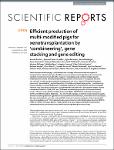Efficient production of multi-modified pigs for xenotransplantation by ‘combineering’, gene stacking and gene editing
Fischer, Konrad
Kraner-Scheiber, Simone
Petersen, Björn
Rieblinger, Beate
Buermann, Anna
Flisikowska, Tatiana
Flisikowski, Krzysztof
Christan, Susanne
Edlinger, Marlene
Baars, Wiebke
Kurome, Mayuko
Zakhartchenko, Valeri
Kessler, Barbara
Plotzki, Elena
Szczerbal, Izabela
Switonski, Marek
Denner, Joachim
Wolf, Eckhard
Schwinzer, Reinhard
Niemann, Heiner
Kind, Alexander
Schnieke, Angelika
Xenotransplantation from pigs could alleviate the shortage of human tissues and organs for transplantation. Means have been identified to overcome hyperacute rejection and acute vascular rejection mechanisms mounted by the recipient. The challenge is to combine multiple genetic modifications to enable normal animal breeding and meet the demand for transplants. We used two methods to colocate xenoprotective transgenes at one locus, sequential targeted transgene placement - ‘gene stacking’, and cointegration of multiple engineered large vectors - ‘combineering’, to generate pigs carrying modifications considered necessary to inhibit short to mid-term xenograft rejection. Pigs were generated by serial nuclear transfer and analysed at intermediate stages. Human complement inhibitors CD46, CD55 and CD59 were abundantly expressed in all tissues examined, human HO1 and human A20 were widely expressed. ZFN or CRISPR/Cas9 mediated homozygous GGTA1 and CMAH knockout abolished α-Gal and Neu5Gc epitopes. Cells from multi-transgenic piglets showed complete protection against human complement-mediated lysis, even before GGTA1 knockout. Blockade of endothelial activation reduced TNFα-induced E-selectin expression, IFNγ-induced MHC class-II upregulation and TNFα/cycloheximide caspase induction. Microbial analysis found no PERV-C, PCMV or 13 other infectious agents. These animals are a major advance towards clinical porcine xenotransplantation and demonstrate that livestock engineering has come of age.
No license information

